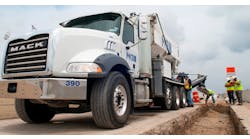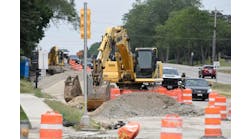By: Allen Zeyher, Associate Editor
The current reconstruction of south Lake Shore Drive in Chicago will be good for motorists and good for Lake Michigan as well.
"Prior to reconstruction, most of Lake Shore Drive drained directly into Lake Michigan, so everything that washes off a typical urban roadway went directly into Lake Michigan," Christopher Wuellner, project manager for the Chicago DOT, told Roads & Bridges. Wuellner is on loan to CDOT from his regular job with Civiltech Engineering Inc., Chicago.
Once the reconstruction is finished, the gasoline, oil, radiator fluid, transmission fluid, salt, sand, brake dust and other grime that washes off the road in the first part of a storm, a so-called "one-year storm," gets directed through the Chicago sewer system to a treatment plant. "We retain, through oversize pipes, the flow from the 10-year storm and then bypass anything above that to the lake," said Wuellner, "but again that flow is much cleaner than what used to go out there before."
More than 6 miles of south Lake Shore Drive between 23rd Street and 67th Street is being reconstructed under a contract with a joint venture of Walsh Construction Co., II in One Contractors Inc. and Riteway. Both II in One and Riteway are minority-owned businesses. Riteway is responsible for managing all of the electrical work but is not performing all the work themselves. Riteway also is operating a movable barrier system from 47th Street to 23rd Street. The barrier switches a reversible traffic lane from northbound (toward downtown) in the morning to southbound (away from downtown) in the afternoon. II in One is performing the construction of the barrier walls, the median wall and the barrier on the outside. They also are responsible for managing various other miscellaneous concrete work like curb and gutter work.
The complete reconstruction was necessary because the pavement had reached the end of its useful life. The project is estimated to cost $162 million. The funding is coming from the state's Illinois First program, with additional funding from the city of Chicago and the Federal Highway Administration.
The new pavement between 23rd Street and 57th Street is a standard Illinois DOT concrete mix design with tining of the finished concrete, according to Wuellner. It consists of about 9.5 in. of portland cement concrete (PCC) over almost 12 in. of aggregate subgrade.
Between 57th Street and 67th Street, they needed a different pavement design through Jackson Park.
"It was just purely aesthetics," said Wuellner. "Jackson Park has a long history, a very important history to the city of Chicago. It was the site of the World's Columbian Exposition in 1893. It is on the National Register of Historic Places. It is very park-like.
"The feeling of the department and the consensus of the community was that an asphalt roadway in Jackson Park would be more fitting with the park environment," Wuellner said.
Agreement on how to conduct road reconstruction through Jackson Park was reached through extensive community involvement. The public participated through the creation of the Lake Shore Drive Advisory Group, which included representation from the local alderman, the park advocacy groups, the Lake Michigan Federation, Friends of the Parks, the Jackson Park Advisory Council and a number of other civic and neighborhood groups.
"We tried to make it not look or feel like an expressway," said Wuellner. Noise was a major factor in deciding on the pavement design. The research CDOT and the other agencies looked at indicated that asphalt tended to be a little quieter than concrete.
The pavement through Jackson Park consists of almost 6 in. of granular sub-base, a 9-in. PCC base course, 1.5 in. of binder and a 1.5-in. asphalt surface layer.
A ride through the park
Along with rebuilding the pavement, the contractors will be improving the pedestrian and bicycle paths through Jackson Park. They are even building a boardwalk, the first in Chicago, along the lake shore at the 57th Street beach.
In addition to improving pedestrian and bike paths in Jackson Park, the project includes improving access to the lake shore from the neighborhood by installing five new pedestrian underpasses. The underpasses utilize three-sided precast structures made by Con/Span Bridge Systems, Dayton, Ohio.
Planning for reconstruction of south Lake Shore Drive started in 1998, and it was always considered more than just a repaving job. Both Mayor Richard M. Daley's office and the community wanted to address long-standing issues such as storm water drainage into Lake Michigan and access to the lake shore from the neighborhood.
Another issue they wanted to address was traffic flow along the drive. One trouble spot was northbound approaching 47th Street, where drivers in the left lane would have to merge right if they were not exiting left. "That obviously creates congestion in the next lane," commented Wuellner. "The configuration of those lanes has been fixed so that mainline traffic can stay where it's at, and if you're exiting at 47th then you merge into the exit lane."
There was a similar situation around 31st Street northbound.
In another area there was pavement that was not being used for traffic. It was used when the drive was originally constructed, but subsequent reconfigurations moved traffic out of the area. The current reconstruction is reclaiming that 14-acre area as green space with landscaping, trees, bushes, perennials and ornamental grasses.
During the reconstruction, CDOT is keeping five lanes open at all times, two in each direction plus a reversible lane in the middle. They rebuilt the southbound lanes first. They built temporary pavement outside of the northbound lanes, shifted the traffic over and reconstructed the two outside southbound lanes. Then they reconstructed the two inside southbound lanes, then the two inside northbound lanes. When Roads & Bridges visited the site in late April, they were rebuilding the two outside northbound lanes.
To reverse the reversible traffic lane CDOT is using a Quickchange Movable Barrier System made by Barrier Systems Inc., Rio Vista, Calif. The barrier transfer machine has an inverted conveyor system from one side of the machine at the front to the other side at the back. As it drives along, it catches each section of barrier wall, lifts it up, passes it to the end of the line and sets it down on the other side of the lane.
This is the first time that such a movable barrier has been used in the Chicago area. It takes the machine 45-60 minutes to reverse the center lane between 47th Street and 23rd Street.
In its final configuration, as in its pre-reconstruction configuration, south Lake Shore Drive will accommodate four lanes of traffic in each direction for most of its length.
Reconstructing Lake Shore Drive through Jackson Park required a detour rather than a simple lane shift because crews had to remove and replace the park's historic Animal Bridge. The bridge carries what is there called Coast Guard Drive over the channel between the south harbor and the inner lagoon.
Caution: Animal crossing
The Animal Bridge in Jackson Park, with its carved heads of rhinoceros and hippopotamuses, was built in 1904 as part of a plan set out by Frederick Law Olmsted in 1871 for a park with a series of lagoons, scenic roads and picturesque bridges. Construction of the Animal Bridge was delayed more than 30 years because of the Great Chicago Fire of 1871 and the 1893 World's Columbian Exposition, which was hosted by Jackson Park.
Over the 20th century, the Animal Bridge had collected a coating of soot and grime that obscured the ornate sculptures.
To restore the bridge, CDOT removed each sandstone and granite piece after it was catalogued and mapped. Each stone's location was mapped and its condition recorded. Then the stones were taken to a warehouse, cleaned and repaired.
"A couple of the original animal head carvings had broken off over the years, so new ones are being carved to match the old ones," said Wuellner.
Once all of the stone was removed, the rest of the concrete arch structure was demolished. The reconstructed bridge will be about 20 ft north of the old one to accommodate a new pedestrian underpass. A Con/Span precast arch forms the core of the reconstructed Animal Bridge. In late April, crews were reassembling the cleaned animal-head carvings and the other original stone over the arch base.
"Once it's complete, when you look at it from the channel side, it'll look exactly like the original structure, except a lot cleaner," said Wuellner. "We even have to restore the same soil line along the outside edges of the bridge. That was a requirement of the Illinois Historic Preservation Agency."
The finished bridge will accommodate both vehicles and pedestrians.
To move the bridge over, the contractors had to build a new sea wall in what used to be part of the channel from the lake to the inner harbor. They built a cofferdam so they could work on the bridge from a dry area.
In late April, mainline paving north of Jackson Park was about two-thirds complete, and road work in Jackson Park was scheduled to be completed by the end of the year. The whole project, including landscaping, was about half finished and scheduled to be completed in early 2004.
The contractor had a limited time to finish reconstructing the Animal Bridge. Because of the boating season, they had only from Oct. 15 to the following May 15 to do the work. The work took two of those seasons. They were required to flood the channel again on May 15. Then the boaters will again be able to cruise into harbor under the gaze of the rhinos and hippos.
About The Author: Allen Zeyher is associate editor of Roads & Bridges.


